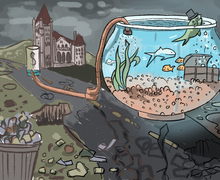Experts discuss toxic algae blooms in central New York
Tori Thomas | Contributing Illustrator
The toxins found in blue-green algae blooms can create skin irritations and in high concentrations can prove fatal.
Freshwater lakes in central New York attract plenty of people seeking relief from the summer heat. But area residents should be mindful — these bodies of water are also potential breeding grounds for blue-green algae, which can be toxic.
Blue-green algae blooms are a recurring problem in New York, according to Syracuse.com. This summer, though, blooms are predicted to be particularly bad due to warm weather in the region, per Syracuse.com.
“It’s a very, very old organism. It’s been around since the beginning of time,” said Greg Boyer, a professor of biochemistry at the State University of New York College of Environmental Science and Forestry.
The algae, also known as cyanobacteria, grow in stable bodies of water such as lakes. The algae are fed by sunlight, often growing from nitrogen and phosphorus that runs off land.
“Traditionally, what’s thought is lakes that have excess nutrients in them can allow blue-green algae to bloom,” said John Halfman, a professor of geolimnology and hydrogeochemistry at Hobart and William Smith Colleges. “Some varieties of blue-green algae will on occasion synthesize toxins, which can be toxic to warm-blooded animals.”
Syracuse, which gets most of its drinking water from nearby Skaneateles Lake, has never had issues due to this type of algae.
However, toxic blooms were detected in Owasco Lake in 2015. That lake provides water to the city of Auburn, which subsequently faced water restrictions.
Algae amounts detected by the Cayuga County Health Department in the Auburn water supply last year were “below the U.S. Environmental Protection Agency health advisory level for short-term exposure,” per Syracuse.com.
“Maybe a hundred of the ten thousand can produce some pretty nasty toxins,” Boyer said, referring to the algae. “They can even produce liver toxins. They can produce neurotoxins. They can produce what are called dermotoxins, that cause your skin to break out in rashes, and things like that.”
The toxins found in this algae can create skin irritations and in high concentrations can prove fatal. It is difficult to detect human interaction with the algae because it typically causes flu-like symptoms.
Officials and scientists can identify the presence of blue-green algae by testing for the chlorophyll pigment. That same pigment also gives waters a green tinge.
“There’s certain field instruments that actually detect the pigment of blue-green algae, that can differentiate it from different algal groups,” Halfman said, referring to the process of testing for different kinds of algae blooms.
Boyer said bodies of water in central New York get some natural relief from these types of blooms because the algae cannot survive cold winters. Disrupting the water will also cause blooms to dissipate.
The struggle against these types of algae blooms is not limited to central New York.
“I just returned from a conference where we were dealing with issues in Africa, and China … and Brazil,” Boyer said. The elements required to create cyanobacteria blooms, he said, are “not unique to New York at all. And any place in the world that has pollution in the form of sewage coming into their bodies often (deal) with algae blooms.”
Boyer added that New York has a good water testing system, specifically for blue-green algae, which might explain the algae’s high appearance rate in the state.
Published on July 1, 2017 at 2:43 am
Contact JP: jphadley@syr.edu





